Leaverites - Features in Metamorphic and Deformed Rocks
Steven Dutch, Professor Emeritus, Natural and Applied Sciences, Universityof Wisconsin - Green Bay
Large Crystals (Porphyoblasts)
Augen
Strain Shadows
Folds
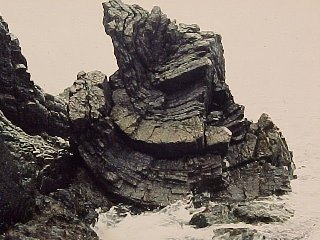 | Rocks that fold at low temperatures and pressures tend to fold like this - the layers bend like a stack of rubber sheets and maintain fairly constant thickness. Note that the layers in the center become contorted because they lack room to move. West coast of Scotland south of Glasgow. |
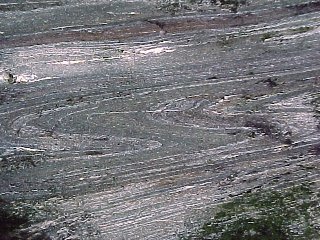 | More plastic rocks deform like these rocks on Gibbs Island, Antarctica. Some rocks are highly plastic by nature, but rocks of all kinds become plastic at high temperatures and pressures. We can define the axial plane of the folds as the surface that connects the sharpest bends in each layer. Here the axial planes are horizontal. Note that the thickness of the layers varies tremendously, but the thickness measured parallel to the axial plane is much more nearly constant. Basically the layers have no mechanical significance; the rock flows under pressure and the layers simply smear out, like smearing striped cake icing with a knife. |
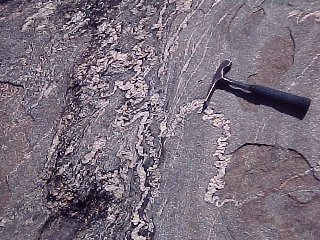 | Rocks with really complex histories often look like this. Often there is no discernible pattern to the folding. |
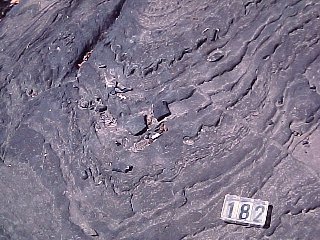 | When rocks fold, individual layers within the fold often crinkle. These small folds tend to have S-shapes on one side of the axial plane and z-shapes on the other. The significance of these minor folds is that the geologist can tell which side of a large fold she is on and locate its axial plane by observing the shapes of the small folds. |
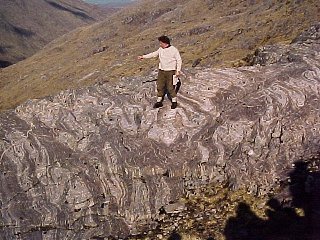 | Using the shapes of minor folds, it's possible to work out the structure of even intensely deformed rocks. At first glance these rocks in the Scottish Highlands look hopeless, but closer inspection shows that, as intricately folded as the rocks are, they basically define a syncline. The geologist on the outcrop figured that out, and eventually zeroed in on a place where it could be seen, by mapping the shapes of small folds in the rocks. To participants (survivors), the day this photo was taken will live forever in memory as the Black Friday Death March. To get here, we climbed 3,000 feet up one mountain, 1,500 feet into a valley and 1,500 feet up the other side. It is now 4 P.M. and we are 8-1/2 miles from the nearest road. |
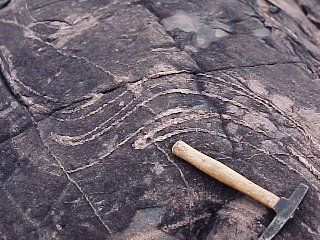 | Rocks can be folded more than once, as these gneisses near Sudbury, Ontario were. |
Kink Bands
Foliation
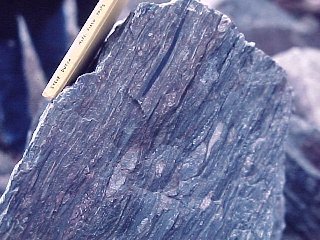 | Deformed rocks develop a sheetlike structure called foliation. one way foliation can form is simply by flattening existing strucures in the rock. This rock near Gander, Newfoundland was once a conglomerate - granitic pebbles have been flattened by over 50 per cent but the black slate pebbles have been flattened almost paper-thin. |
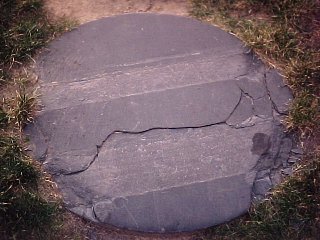 | Foliation is not bedding. This slate paving stone near Independence Hall, Philadelphia was split along a foliation surface, but weathering has revealed the original bedding in the rock. |
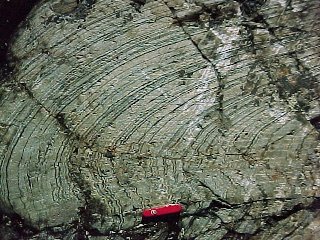 | Some foliation forms when materials are removed from the rocks by solution. The fine parallel cracks in this fold formed that way. The solutions move in the direction of least resistance, parallel to the axial plane of the fold. |
Boudinage
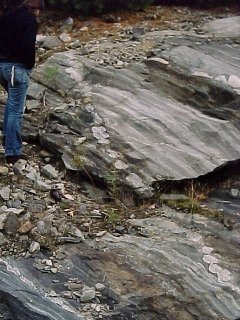 | When rocks are compressed, they often are extended at the same time in some other direction. The granite dike cutting this gneiss near Bucksport, Maine has been stretched until it broke into a series of discrete blobs, a process called boudinage (from the French word for sausage.)
|
Return to Mineralogy-Petrology Index
Return to Thin-Section Index
Return to Crystals and Light Index
Return to Crystal Structures Index
Return to Mineral Identification Tables
Return to Professor Dutch's Home Page
Created 15 October 2009, Last Update
Created 22 April, 2005, Last Update